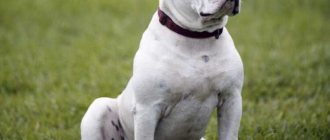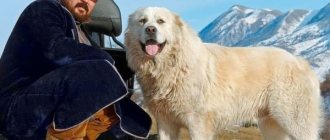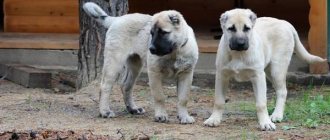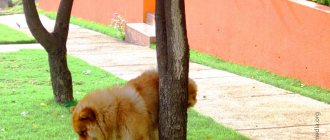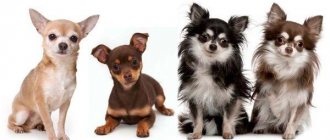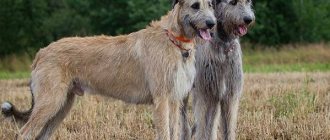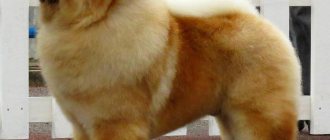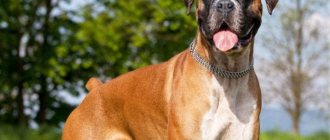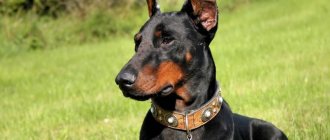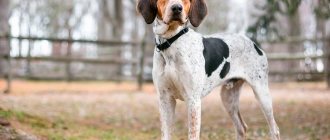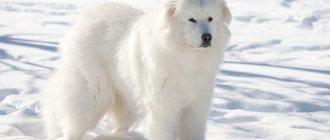Akbash
- Origin: Turkey
- Height: from 69 to 86 cm
- Weight: from 41 to 64 kg
- Life expectancy: 10 to 11 years
- Temperament: intelligent, loyal, independent, fearless
The Akbash is an ancient breed that originated in the plains and mountains of western Turkey, where it was bred by villagers and shepherds to protect livestock from wolves and other predators. Although the Akbash is the Turkish counterpart to other white guard dog breeds found in the northern Mediterranean basin, it is the only breed that has a distinct combination of mastiff and hound characteristics .
Like other hounds, the Akbash is distinguished by long limbs, a deep chest and a tucked belly. The influence of the Mastiff breed is evident in height, weight, broad head and powerful body. The wedge-shaped head is adorned with floppy ears, and the long tail curls behind the back when moving or excited.
This white, lean, muscular dog has a wary gaze and a regal appearance that conveys all its power, strength and courage. Akbash also has the speed and agility it needs to fight and chase predators.
Akbash can be both a domestic companion and a guard dog. He is calm, quiet, independent and balanced. Akbash is loyal, affectionate and attached to his human family, children and other pets. He is naturally wary and suspicious of strangers and can be territorial towards other dogs. This dog takes well to training and must be properly socialized from an early age to become a good family dog.
This white dog breed's medium to long coat, which may have a slight biscuit or gray tint around the ears or undercoat, should be brushed weekly to remove dirt and loose hair. Periodic bathing, regular teeth brushing and nail trimming are also among the breed's basic grooming needs. Although the Akbash's activity level is relatively low, this pet is best suited to homes with a large fenced yard that provides it with plenty of room to run around.
Basic moments
- Despite the innate intolerance towards large predators, at heart the “Irish” remains a relatively peace-loving and gentle dog, suitable for the role of a harmless pet.
- It is impossible to train Irish wolfhounds to be aggressive fighters, and they also make very mediocre watchmen.
- In their homeland, the animals have the status of a national breed, and the Royal Irish Regiment long ago chose them as their mascot.
- The Irish Wolfhound is not an empty talker, although sometimes it is not averse to chatting in a low, chesty bass voice. Most often, a dog vocalizes out of boredom when forced to spend time alone.
- Every year, on St. Patrick's Day, the Queen of England honors the Irish Guards by presenting a bouquet of shamrocks not only to the military, but also to the Irish wolfhound serving in the court service (in recent years, the honorary mission has been entrusted to Prince William's wife, the Duchess of Cambridge).
- Representatives of this breed grow slowly and become truly adult dogs by the age of two.
- It is believed that the Irish are very patient, but their reserve of endurance is not unlimited. The easiest way to provoke a dog into aggression is by attacking its owner: no one, even the most phlegmatic dog, will tolerate such disrespect.
- The intellectual indicators of Irish wolfhounds are high. They easily remember commands, but do not tolerate overt drilling.
- The correct “Irish” is always kind and indulgent towards children.
- The Irish Wolfhound is not the best friend for domestic cats and other small animals. A rare dog is able to suppress his hunting instinct and calmly walk past a cat lounging on a pillow. Most often, the residence of a dog and a cat in the same territory ends in the death of one of them (guess who).
The Irish Wolfhound is a straightforward, shaggy giant who will willingly share with you the secret of the purest and most sincere friendship. Born for dangerous and difficult work, today this formidable giant has retired a little, without losing his sports skills and hunting instincts. However, do not rush to be enchanted by the brutal and emphatically harsh appearance of the Irish Wolfhound and do not try to consider it a ferocious defender of your property. Under the mask of seriousness and feigned menace hides an intelligent, sensitive, but not at all suspicious creature who will never allow herself to offend a person.
Anatolian Shepherd (Kangal)
- Origin: Turkey
- Height: from 63 to 80 cm
- Weight: from 40 to 60 kg
- Life expectancy: 11 to 13 years
- Temperament: sensitive, independent, alert, protective, calm
The Kangal is a large, powerful, strong dog with great endurance and agility. This breed's coat consists of a thick undercoat and an outer coat that is slightly longer on the neck and mane. The Anatolian Shepherd gives the impression of being a brave but calm protector.
The Anatolian Shepherd is an ancient breed with a long working history. The dog's roots probably go back to the Tibetan mastiff and Roman war dogs that came to Turkey more than 4,000 years ago. Here they were valued as hardy protectors of livestock from formidable predators, including wolves and bears. Kangals accompanied nomadic shepherds and became widespread, which explains the large differences between Anatolian Shepherds in size, coat type and color. However, some traits that have remained constant throughout the breed are loyalty, independence and endurance.
Did you know that the Turkish name for this breed - koban kopegi - means herding dog .
This is a calm and loyal breed of dog that will never back down when in danger. Kangals are suspicious of strangers and are territorial. Although they are good with children, they may not be playful enough for them.
The Anatolian Shepherd needs the opportunity to exercise every day, whether it's a long walk or a fast run, and it needs the companionship of its family. Grooming is minimal and consists only of weekly brushing.
Gampr (Armenian wolfhound)
- Origin: Armenia
- Height: from 58 to 66 cm
- Weight: from 45 to 61 kg
- Life expectancy: 12 to 15 years
- Temperament: intelligent, strong-willed, relatively independent, courageous
The Gampr is an old breed of large to gigantic dog that began to evolve in the Armenian Highlands as a livestock protector thousands of years ago. These dogs are naturally caring and affectionate with both livestock and family members of any age, but they can be more serious and aloof than most breeds and are not playful . Although gampras are intelligent, courageous, and generally calm, they do not get along well with other animals unless they receive significant socialization.
Numerous carvings and engravings of dogs have helped trace the history of the breed, and by 1000 BC, most of these petroglyphs appear to be dedicated to Gampras, indicating that the breed was not only well known by this time, but was also preferred.
Did you know that after the invasion of the Ottoman Empire, the number of these powerful dogs decreased sharply, but, on the other hand, they became more widespread. They were even used as the basis for creating various Turkish breeds. And thanks to them, the Caucasian Shepherd appeared in the Soviet Union.
Gampras evolved as guards, protecting livestock from large predators. Only a big and strong dog can cope with such opponents. The Armenian Gampr is just like that: muscular, with a long, straight back and pronounced shoulder blades. Dogs still used as livestock protectors often have their ears cropped , as this prevents large predators from biting and holding their ears, gaining an advantage.
This breed has a two-layer coat consisting of a thick undercoat and a coarse outer coat that protects against both the elements and predators. Their coats contain protective oils that help shed dirt and debris and also protect the skin, so bathing should only be done a few times a year as needed, and weekly brushing with a rake will usually prevent large clumps from forming.
IMPORTANT! These dogs are known to grow slower than others and may benefit from a diet designed for large breed puppies until their growth slows.
Although the Armenian Gampr is not an overly energetic animal, it is a working dog breed and requires a moderately high level of exercise to stay healthy. This is a very large breed of dog, so exercise that puts stress on the joints, such as jumping, long runs and even climbing stairs, should be kept to a minimum, especially while the pet is still growing. This will help avoid bone and joint problems as your dog gets older. A long daily walk is excellent exercise for these dogs, and since they are most active at dawn and dusk, this may be the best time for walks.
How to determine the gender of a puppy by appearance: diagram
First of all, not only behavior differs, but also sexual characteristics. The fact is that at such a young age, for example, immediately after birth, and up to about 4 weeks, the genital organs of puppies are practically not formed. That is, boys do not have a clearly defined penis, while girls have a tightly closed genital opening. Accordingly, it is quite difficult to figure out where the boy is and where the girl is. But with certain skills, it is still possible to easily find out whether this is a male or a female.
Instructions:
- To determine, it is best to choose a day when the puppies are calm. For the first few weeks, it is advisable not to touch the puppies at all, so as not to weaken their scent. The fact is that the mother of the babies is guided directly by the smell of the puppies, therefore, if it is overwhelmed by perfume or some kind of perfume, then the mother in labor may abandon her babies. To prevent this from happening, try not to carry the puppies in your arms for the first few days.
- After a few weeks have passed, the sex of the puppies can be determined. To do this, take a large terry towel, which should be preheated on a radiator or heater. Next, the towel is laid out on a large feather pillow, in which a recess is made. Thus, you get a kind of hammock. You need to place the puppy in it with its back in the recess, so its paws will stick out at the top and its tummy will look at you.
- Now you can begin the inspection. Females have small dots in the upper part, these are nipples. Males also have them, but they are seen quite rarely, or are practically not identified. Next, you need to look at the bulges in the groin area. In puppies up to one month old, the penis may not be at all pronounced.
- But in this place there is already a small tubercle, as well as a decent accumulation of hair. That is, if you see a tuft of hair on your puppy’s tummy that covers some small tubercle, most likely it is the penis. Now you can look in the area under the tail. Males have only one hole in this area. That is, the anus. Males do not have a second button, which is the vaginal opening.
It is worth noting that there is no need to look for genital appendages in males up to one month old. The fact is that at this age they are practically not formed, they are not there. They descend after some time into the scrotum. But there may also be a small accumulation of hair, that is, fur, in this place.
Diagram of genital organs
Russian greyhound (Russian wolfhound)
- Origin: Russia
- Height: from 68 to 85 cm
- Weight: from 34 to 40 kg
- Life expectancy: 7 to 10 years
- Temperament: calm, affectionate, courteous, intelligent, independent
Russian Wolfhounds have the elegance and grace of a greyhound, and are able to run quickly like hounds even in very cold climates. They have the body type of a greyhound, which is necessary for running at high speed, but this breed is larger and stronger than other greyhounds. The long, silky coat, which can be smooth, wavy or rather curly, provides protection from cold and snow.
The Russian Greyhound was bred by the Russian aristocracy hundreds of years ago. Her ancestors were known in Russia back in the 13th century . In the fifteenth and sixteenth centuries, they decided to improve the breed by crossing racing hounds with bear hounds and with tall Russian shepherd dogs to increase the size and length of the coat necessary for hunting in cold climates.
The first standard was described in the 1600s in a book of rules for hunting with greyhounds. Hundreds of serfs cared for dogs on vast estates; the hunt itself was a grand event. More than 100 greyhounds could take part in the hunt.
Fun fact: By the 1800s, there were seven different subtypes of Russian greyhounds in Russia. The Russian Tsar often presented greyhounds as gifts to royal families. After the Russian Revolution, the times of the nobility ended and the breed began to lose popularity.
Representatives of this Russian breed of dogs behave quietly and obediently indoors. Outdoors, they run with wild abandon and will chase any running animal. Russian Greyhounds are independent but very affectionate with their family. Although they are generally good with children, they may not be playful enough for them. Some may even be timid and shy away from strangers.
Russian Wolfhounds need opportunities for daily exercise. While a long walk can satisfy most of their needs, it should be combined with sprinting in a large, safe area. The coat, which is usually thicker on males, needs brushing two or three times a week; At times the dog sheds a lot.
TOP nicknames
When choosing a name for your Irish, give preference to simple, consonant nicknames. Do not forget that you will have to repeat it several times a day. It is advisable that you really like it. In this case, your devoted friend will completely love the chosen name.
Recommended nicknames for the Irish Wolfhound “boy”:
- Luther;
- Werther;
- Winston;
- Martin;
- Charles;
- Windsor;
- Jack;
- Whist;
- Tower;
- Bernard;
- Vector;
- Tybalt.
When choosing a name for a “girl” Irish wolfhound, pay attention to the following nicknames:
- Margo;
- Vesta;
- Hera;
- Lilith;
- Troy;
- Scarlett;
- Megan;
- Sparta.
Caucasian Shepherd Dog (Caucasian Mountain Dog, Caucasian Wolfhound)
- Origin: Caucasus
- Height: from 67 to 70 cm
- Weight: from 50 to 100 kg
- Life expectancy: 10 to 12 years
- Temperament: strong, alert, dominant, calm, playful
The Caucasian Shepherd is a strong and athletic dog with strong muscles and strong bones. It has a large wedge-shaped head and a thick, curved tail. The breed is often recognized by its dark mask on the face against a background of thick fur in shades of gray, fawn or red with white markings.
The Caucasian Shepherd Dog is an ancient dog breed originating from the Caucasus region of Eastern Europe, where it was used to guard and protect herds, flocks and villages from predators and intruders. Research shows that the Caucasian Shepherd Dog is a close relative of the Balkan Shepherd Dogs and Asian Mastiffs. Since the 1920s, Caucasian Shepherd Dogs have selectively developed such valuable qualities as strength, confidence, courage, endurance, keen hearing and vision. The breed was recognized by the United Kennel Club in 1995.
The brave, energetic and strong-willed Caucasian Shepherd quickly defends its family and property. She is territorial towards strangers and other dogs, but is also gentle and kind towards her human family. A stable and even-tempered Caucasian Shepherd requires proper socialization and patient training to avoid any potential aggression.
The thick double coat of the Caucasian Shepherd can range from short to very long. Those with longer hair should be brushed daily, while short-haired dogs should be brushed weekly. In addition, they should regularly trim their nails and clean their ears and teeth.
The Caucasian Shepherd is a calm breed with relatively low energy, but it enjoys daily walks or outdoor play and has enough stamina to endure long walks or hikes. Walking on a leash and free play in a large fenced yard are best for this intelligent and independent breed . The Caucasian Shepherd, although active outdoors, is quiet inside the house.
Varieties
If we talk about colors, there are five varieties of Irish Wolfhounds that are most often found.
- Grey. This is the most common type. The color of the coat can vary from the lightest shades to the deepest. This palette is usually diluted with black areas on the face and ears.
- Black. This is the main coat color. It may be diluted by white markings located on the paws or chest. But such areas should not be large. Over time, the pet may acquire a lighter shade, but the undercoat always remains black.
- White. A completely white coat color is very rare for the Irish Wolfhound. Most often, the pet acquires a creamy tint. A distinctive feature of white dogs is the complete absence of dark marks.
- Ginger. Quite a common color. A pet can have any shade of red color. Sometimes the fur even appears reddish.
- Brindle. A small puppy may have a beautiful brindle pattern. As a pet grows up, it can darken significantly and even become monochromatic. But the undercoat will retain a beautiful brindle pattern. And if the dog acquires a wheat, cream or light gray tone, then the original pattern will be visible through the main coat.
Giant Schnauzer (Bavarian Wolfhound)
- Origin: Germany
- Height: from 60 to 70 cm
- Weight: from 25 to 48 kg
- Life expectancy: 12 to 15 years
- Temperament: strong, smart, kind, loyal, strong-willed, dominant
This is a larger and more powerful version of the standard Schnauzer. It has a strong, compact and almost square body, combining great strength and agility. The Giant Schnauzer's double coat consists of a soft undercoat and a tough, dense outer coat—a combination that once allowed them to withstand harsh alpine conditions . Their signature beard and eyebrows combine with elegant contouring to create a striking figure.
The Giant Schnauzer originated in rural areas of Bavaria and Württemburg. Cattlemen there were impressed by the small standard schnauzer and sought to produce them on a larger scale that would be suitable for herding cattle. It is likely, although not documented, that they crossed the Standard Schnauzer with the local larger smooth-coated mushers. Later crossbreeding took place with rough-coated shepherd dogs, Great Dane and Bouvier des Flandres, and even crosses with the black poodle, wolfish spitz and wirehaired pinscher were proposed.
Did you know that this intelligent dog was previously known as the Munchener . The created breed received little exposure until the First World War, when it was proposed to train them as police dogs.
The playful, boisterous Giant Schnauzer may be too boisterous for small children, although he is otherwise very good with the children in his family. Giant Schnauzers are brave and loyal to those close to them and reserved with strangers. Bavarian Wolfhounds can be assertive towards other dogs. This energetic breed is a good choice for an active person looking for an adventure partner, although sometimes the Giant Schnauzer may try to become a leader.
The Giant Schnauzer needs daily exercise and entertainment. His exercise needs can be met through vigorous play and long hikes or walks. Your pet's coarse coat should be brushed once or twice a week and trimmed two to four times a year. Shaping the “hair” is best done by professional groomers.
Typical behavior of a Caucasian
We already know that, in general, the wolfhound is a guard breed, therefore, all its representatives must have a tough character. It is this quality that concerns the Caucasian, who has been hunting the most violent predators since ancient times. The very first wolfhounds lived in the wild. They fed on both small forest inhabitants and predators. When people began to domesticate them, the breed became famous throughout the world. They went hunting with wolfhounds of this color in all corners of the world, since only they were able to kill animals such as lynx, wild boar or deer. Today they are used as the best watchmen and security guards. Due to the fact that the animal’s character is very ferocious, it recognizes only its owners. The owners claim that the dog is not very playful, but requires constant physical activity in order to keep its muscles in good shape.
Pyrenean Mountain Dog (Pyrenean Wolfhound, Pyrenean Mountain Dog)
- Origin: France, Spain
- Height: from 65 to 82 cm
- Weight: from 36 to 54 kg
- Life expectancy: 10 to 12 years
- Temperament: gentle, fearless, annoying, self-confident, strong-willed, patient
Elegant, imposing and majestic, the Pyrenean Wolfhound is a large dog of medium build. Because of its thick coat, the Pyrenees Mountain Dog looks larger than it actually is.
This breed was bred to guard herds on steep mountain slopes, so it must combine strength with agility. The Pyrenees Mountain Dog moves smoothly . The weather-resistant double coat consists of a dense undercoat and long, coarse outer hairs, providing excellent insulation against the Pyrenean cold.
The Pyrenean Mountain Dog is a balanced and imposing guard dog. This breed is devoted to its family and is somewhat wary of strangers - people or dogs. If the Pyrenean Wolfhound is not provoked, it will behave calmly and unperturbed. The breed is very gentle with children, but has an independent and somewhat stubborn character . Since they are guard dogs, they should be kept on a leash. For the same reason, the Pyrenees Mountain Dog will bark loudly at any outside noise.
These dogs require daily exercise to stay in shape. A moderate walk is usually sufficient. The Iberian Wolfhound enjoys hiking, especially in cold and snowy weather, but does not do well in the heat. This dog's coat needs to be brushed once or twice a week, and when shedding, daily. Some pets may drool from time to time.
Overall this is a healthy dog. The main problems may be associated with ischemic heart disease and patellar dislocation. Minor problems: entropion, OCD, skin problems, osteosarcoma, cataracts, chondrodysplasia (dwarfism), panostitis. Sometimes gastric volvulus, otitis externa, and muscular atrophy of the spine are observed.
Buribosar
Buribosar
Buribosar. The Uzbek wolfhound Buribosar is a type of Central Asian shepherd dog. Harsh living conditions made these dogs strong and unpretentious, and taught them to use their energy sparingly. These are protector dogs, companion dogs. They have a highly developed instinct to protect not only themselves, but also the territory in which they live, as well as the owner’s property. Being on their own territory, Uzbek wolfhounds always show viciousness and distrust of strangers.
Irish Wolfhound
- Origin: Ireland
- Height: from 71 to 86 cm
- Weight: from 40 to 55 kg
- Life expectancy: 6 to 10 years
- Temperament: gentle, noble, thoughtful, devoted, patient
The tallest of the greyhounds, the Irish Wolfhound is similar to the rough-coated Greyhound, although of a more powerful build. Large sizes were especially valued in the breed. This combination of speed, power and size allowed the Irish Wolfhound to bring down and subdue large prey. Despite its size, the breed has an elegant physique, an easy gait and a proud posture. The coat is coarse and provides protection from cold and damp, especially harsh and long over the eyes and under the jaw.
It is believed that in 1500 BC. e. Huge dogs were brought to Ireland from Greece. In Ireland they became even more impressive, and these large dogs were given to Rome. The first mention of the Irish wolfhound dates back to 391 AD. The breed has historically become famous for its impressive stature and fighting abilities.
Interesting fact: the Irish name for the breed is Cu Faoil . All large hounds were once known as Cu, meaning "courage". The breed was so popular in Ireland that it became the subject of many legends telling of its prowess in battle and hunting wolves and Irish elk.
These hounds were traditionally given as gifts to foreign nobility . This practice, along with the extinction of wolves in Ireland in the eighteenth century, contributed to the decline of the breed. By the nineteenth century, Irish wolfhounds were nearly extinct in Ireland, and the famine of 1845 virtually wiped out the breed. In 1869, Captain G.A. Graham decided to resurrect the Irish Wolfhound by crossing the few remaining wolfhounds with the Scottish Deerhound, Great Dane, Greyhound and even the Tibetan Wolfdog. First introduced at a dog show in the 1870s, the revived wolfhound created a sensation—and continues to do so today.
A gentle giant is an apt description for this good-natured, easy-going breed. The Irish Wolfhound is calm, sensitive, patient, flexible and sweet in the house. Despite its large size, this breed gets along well with children, pets and other dogs. The Irish Wolfhound is friendly with strangers and courageous when the need arises.
The Irish Wolfhound loves a long walk and a chance to stretch its paws, so this breed needs daily exercise. Enough space is required in the house for the dog to stretch out on a soft surface; This breed does not tolerate living in crowded conditions. The coat should be brushed once or twice a week, and loose hairs should be removed from time to time with light scissors.
Character and qualities that these dogs have
Wolves are considered very dangerous animals. They are capable of destroying an entire pack of hunting hounds, systematically killing one dog after another. Ordinary greyhounds or fighting dogs, even if they have considerable strength and mobility, will not be able to cope with such a serious beast. Therefore, animals participating in wolf hunting or, conversely, protecting property and livestock from attacks by “forest orderlies” must have specific qualities:
- Dexterity, courage, fearlessness are qualities that are indispensable for a hunter or watchman.
- High intelligence, intelligence, quick wit.
- Fast and accurate following of human commands.
- Exceptional security and protective working qualities, lightning-fast reaction, very sensitive hearing.
- A pronounced desire for discipline and order. All these qualities make wolfhounds the best hunters and protectors. They are able to go for a long time without food and water, fulfilling the task set by man - be it protecting the territory of a country house or protecting the herd from coyotes, wolves and foxes.
However, these beautiful, self-confident animals also have some negative traits that must be taken into account when choosing a breed:
- It is not recommended for dog breeders without experience in raising and training large dogs to own a wolfhound.
- Not suitable for people with a soft, compliant character. Wolfhounds are strong animals with a pronounced desire for dominance and the ability to make independent decisions and take further action. Dogs need an unconditional leader - only in this case the owner will be able to build a successful relationship with the pet.
- They absolutely cannot be kept in an apartment or on a chain.
- They have poor contact and practically do not get along with other animals.
Maremmo-Abruzzese Shepherd Dog
- Origin: Italy
- Height: from 60 to 73 cm
- Weight: from 30 to 45 kg
- Life expectancy: 11 to 13 years
- Temperament: friendly, intelligent, loyal, determined, noble, alert
Large, robust and strong, the Maremmo-Abruzzese Shepherd Dog has a majestic appearance and serves as a guardian of livestock and property. A long, hard coat of white or cream color, reminiscent of polar bear fur, helps the dog to camouflage well among the sheep it protects. The Maremmo-Abruzzese Shepherd Dog has a dense build, a large flat head, triangular ears, a deep chest and a low-set tail.
IMPORTANT! Attentive, fiercely protective and trustworthy, the Maremmo-Abruzzese Shepherd Dog is a loyal, courageous guardian. She gets bored without work, so it is not recommended to have her as a pet.
The affectionate Maremmo-Abruzzese Sheepdog is insightful and unwavering in its relationship with its owner, and forms a close bond with the human family. The Maremmo Abruzzese Shepherd Dog will make a good companion, provided it is kept busy, properly trained and actively socialized from puppyhood.
The Maremmo-Abruzzese Sheepdog's dense undercoat sheds twice a year, usually in spring and autumn, at which time more frequent brushing and bathing may be required. Otherwise, regular grooming, including trimming nails, cleaning ears and teeth, is all that is required to maintain the appearance and health of the breed.
The Maremmo-Abruzzese Shepherd Dog requires moderate exercise , such as daily walks on a leash or free play in a large fenced yard. However, this independent breed requires more effort in obedience training.
Choosing a puppy
The population of Buryat Shepherd Dogs is small, so buying a puppy of this breed is not easy. There are several nurseries specializing in breeding this breed, the largest are located in Ulan-Ude (“Property of the Republic of Buryatia”, “Khotosho”). It is recommended to purchase a pet only from a reliable breeder who will confirm its pedigree with the necessary set of documents (puppy certificate, breeding patent, pedigree of parents, etc.).
Buryat-Mongolian Wolfhound puppies are easiest to find in Buryatia
Price of a puppy of this breed
The cost of a hot dog varies from 25 to 45 thousand rubles, depending on the potential of the puppy and the title of the parent couple. An animal without documents can be found in an advertisement for 10–15 thousand, but in this case there will be no guarantee of thoroughbredness.
Georgian Shepherd (Nagazi, Georgian Wolfhound)
- Origin: Georgia
- Height: from 61 to 66 cm
- Weight: from 46 to 68 kg
- Life expectancy: 11 to 12 years
- Temperament: Alert, protective, calm, confident, strong-willed, courageous, resilient
The Georgian Shepherd is a Molosser breed that was used as a working dog in the Caucasus. Nagazi are dogs with strong bones and an athletic build, a large head, furry ears, powerful limbs and a bushy tail. This breed was used to herd sheep, a tradition that continues to this day.
Georgian wolfhounds are descended from the ancient Molossian dogs and were primarily used as sheep protectors from predators. These rare dogs have even been exhibited at several dog shows. At some point their importance in Georgia declined and most of them were taken out of the country. However, dog lovers turned to the Ministry of Natural Resources for help and made efforts to revive this unique breed.
The herding and protective instincts of the Nagazi make them alert, brave, strong-willed and assertive dogs. They form close bonds with all members of their family, but do not accept or get along with strangers, making them excellent watchdogs . The Georgian Shepherd will also have a good relationship with the children she was raised with and will socialize well with the pet dogs in her family. However, when it comes to unknown dogs, nagazis become territorial. They are also not a good choice for homes with cats and other small pets.
This active breed needs regular exercise and requires long walks and plenty of play time. Georgian wolfhounds do not do well in apartments and prefer houses with a large yard or garden where they can run freely. When walking them, be sure to put a leash on your pet so that it does not run away at the sight of its prey.
IMPORTANT! Due to their dominant nature, Nagazis are not suitable for first-time owners and require a tactful trainer to train them firmly but gently.
Since Georgian Shepherds are wary of strangers, it is very important to socialize your pet from childhood, forcing him to meet different people and experience different situations. In this way, he gradually learns who to accept and who to be careful with. Introduce your nagazi to people who regularly visit your home as early as possible so that she can behave well when interacting with them.
Health
- osteochondrosis of the shoulder;
- osteosarcoma;
- hypothyroidism;
- dilated cardiomyopathy;
- hygroma of the elbow joint;
- hip dysplasia;
- von Willebrand disease;
- pyoderma;
- cataract;
- entropion of the eyelid;
- Wobbler syndrome;
- bloating/volvulus.
Preventive measures to protect your Irish Wolfhound puppy
- To keep your Irish Wolfhound puppy completely safe, you first need to minimize his contact with unfamiliar dogs, especially strays. Therefore, you should not let your dog off the leash, as in this case it will become impossible to control its behavior and communication with other dogs. Since a dog can easily become infected with distemper from simply touching the nose of a sick animal. This disease can be transmitted to a dog through sniffing. Your dog can become infected with trichophytosis from contact with the lichen-affected fur of a sick dog. Naturally, it is impossible to completely exclude a dog’s communication with other dogs, since it must be socialized. Therefore, try to find friends with dog lovers who look after their animals. By adhering to this rule, you can eliminate the risk of pathogen transmission by 80%.
- You should walk your dog in places where there are no landfills. Since garbage very often attracts rodents, which in turn are very often carriers of various infections. Gray rats are especially dangerous because they carry such a serious disease as leptospirosis.
- You should not allow your dog to sniff other people's feces, as they are a source of worms.
- Monitor the well-being of your Irish Wolfhound. Pay attention to even the most minor changes in his behavior. For example, your dog may appear lethargic, lose his appetite, or have a dry nose. Or you may notice that the dog begins to shed, and this has nothing to do with seasonal shedding. If hair loss becomes excessive, this is the first symptom indicating health problems in your pet. And only you can help him. Therefore, it is important to take the dog to the veterinary clinic in time, where the disease can be overcome for sure. In no case should you ignore the symptoms, since advanced infections are much more difficult to treat, and sometimes even impossible. If you start treating your dog, the disease can lead to his death or he will develop serious complications that will affect his hearing, vision, limbs and much more.
Taigan (Kyrgyz greyhound)
- Origin: Kyrgyzstan
- Height: from 58 to 68 cm
- Weight: from 25 to 33 kg
- Life expectancy: 10 to 13 years
- Temperament: excitable, active, calm, alert, intelligent, independent
For centuries, the taigan has been valued by the Kyrgyz as an integral part of their nomadic lifestyle. Taigan was an efficient hunter with amazing vigilance. But at home they are very calm pets, closely bonded with family members, very loyal and devoted. They don't mind having a little fun with the kids or joining in on family outings, but they won't tolerate mistreatment or harsh training methods.
Taigans love to explore and run at will, so they are best kept in a country house where they can freely burn off some of their enormous energy. Kyrgyz Greyhounds are gentle and affectionate with family, but may shy away from strangers but are not aggressive . They get along well with other dogs, but may view smaller pets as prey.
Did you know that the history of the Kyrgyz hound began with the mythical bird-dog. According to legend, an egg was stolen from the nest of a Kumai mountain vulture. After hatching, a puppy appeared, which saved the tribe from starvation by dispersing packs of wolves that regularly attacked their livestock.
Strong and resilient, the taigan was at home in remote, rugged terrain, and was valued by nomadic tribes for its adaptability, reliability, and hunting abilities. However, this brave dog was on the verge of extinction when the nomadic lifestyle gave way to settlements. There was no longer a need for a hunting dog, and many Taigans became homeless animals. To make matters worse, the campaign to kill many stray dogs has further reduced their population. Fortunately, several breed enthusiasts worked to preserve the dogs, but it was not until 1964 that the first breed standard was developed in the USSR.
Interesting fact: Taigans are considered a national treasure of Kyrgyzstan. Taigan means immortal, unquenchable and imperishable.
The most common color of Taigans is black with white markings, but they also come in black, brown, grey, white and gold. Kyrgyz Greyhounds have a beautiful coat that requires regular brushing to keep it in top condition. Bathing is not a requirement; their coat appears to be almost self-cleaning, although it sometimes needs to be wiped with a damp cloth to remove any surface dirt.
Taigan is unsurpassed cross-country runner . Foresight and an exceptional sense of smell make this dog an excellent hunter.
IMPORTANT! You should only consider this cute dog as a pet if you lead an active lifestyle and have a spacious area for the dog. Taigans are not suitable for apartment living, and sometimes even a private town house is a questionable choice for this very energetic dog.
What are the differences?
After we have looked at how to distinguish a wolf from a dog, let’s figure out what causes these differences. All of them are associated with two groups of factors:
- Natural, conditioned by life next to humans, which made it possible to tame animals and change their behavior, while wild predators are still subject to natural reflexes and behavior patterns, without which it would be difficult for them to survive in the wild.
- Artificial, associated with selection, as a result of which changes in the appearance of animals appeared.
It was domestication and living together with humans for thousands of years that became the basis of the differences that can be traced today between the wolf and the dog. After all, once upon a time they were completely absent. Wolves remain active at night, while domestic pets have managed to adapt to the rhythm of human life: they most often rest at night and are awake during the day. At the same time, domestic animals rarely howl, while their wild relatives do not bark in their natural habitat, but if they fall into captivity, the latter are able to adapt to a new environment and use barking as a means of communication.
